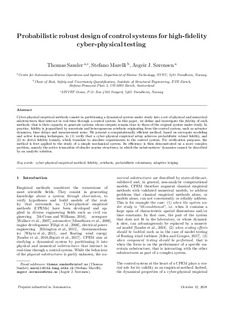| dc.contributor.author | Sauder, Thomas Michel | |
| dc.contributor.author | Marelli, Stefano | |
| dc.contributor.author | Sørensen, Asgeir Johan | |
| dc.date.accessioned | 2019-01-04T18:17:56Z | |
| dc.date.available | 2019-01-04T18:17:56Z | |
| dc.date.created | 2019-01-04T14:42:24Z | |
| dc.date.issued | 2019-03 | |
| dc.identifier.citation | Automatica. 2019, 101 111-119. | nb_NO |
| dc.identifier.issn | 0005-1098 | |
| dc.identifier.uri | http://hdl.handle.net/11250/2579304 | |
| dc.description.abstract | Cyber–physicalempirical methods consist in partitioning a dynamical system under study into a set of physical and numerical substructures that interact in real-time through a control system. In this paper, we define and investigate the fidelity of such methods, that is their capacity to generate systems whose outputs remain close to those of the original system under study. In practice, fidelity is jeopardized by uncertain and heterogeneous artefacts originating from the control system, such as actuator dynamics, time delays and measurement noise. We present a computationally efficient method, based on surrogate modelling and active learning techniques, to (1) verify that a cyber–physical empirical setup achieves probabilistic robust fidelity, and (2) to derive fidelity bounds, which translate to absolute requirements to the control system. For verification purposes, the method is first applied to the study of a simple mechanical system. Its efficiency is then demonstrated on a more complex problem, namely the active truncation of slender marine structures, in which the substructures’ dynamics cannot be described by an analytic solution. | nb_NO |
| dc.description.sponsorship | This work was supported by the Research Council of Norway through the Centres of Excellence funding scheme, Project number 223254 - AMOS, and through the project 254845/O80 “Real-Time Hybrid Model Testing for Extreme Marine Environments”. The material in this paper was not presented at any conference. This paper was recommended for publication in revised form by Associate Editor Angelo Alessandri under the direction of Editor Thomas Parisini. | nb_NO |
| dc.language.iso | eng | nb_NO |
| dc.publisher | Elsevier Ltd | nb_NO |
| dc.rights | Attribution-NonCommercial-NoDerivatives 4.0 Internasjonal | * |
| dc.rights.uri | http://creativecommons.org/licenses/by-nc-nd/4.0/deed.no | * |
| dc.subject | Cyber–physical empirical method | nb_NO |
| dc.subject | Fidelity | nb_NO |
| dc.subject | Artefacts | nb_NO |
| dc.subject | Probabilistic robustness | nb_NO |
| dc.subject | Adaptive kriging | nb_NO |
| dc.title | Probabilistic robust design of control systems for high-fidelity cyber–physical testing | nb_NO |
| dc.type | Journal article | nb_NO |
| dc.type | Peer reviewed | nb_NO |
| dc.description.version | acceptedVersion | nb_NO |
| dc.rights.holder | © 2018 Elsevier Ltd. All rights reserved. | nb_NO |
| dc.source.pagenumber | 111-119 | nb_NO |
| dc.source.volume | 101 | nb_NO |
| dc.source.journal | Automatica | nb_NO |
| dc.identifier.doi | 10.1016/j.automatica.2018.11.040 | |
| dc.identifier.cristin | 1650575 | |
| dc.relation.project | Norges forskningsråd: 223254 | nb_NO |
| dc.relation.project | Norges forskningsråd: 254845 | nb_NO |
| cristin.unitcode | 7566,9,0,0 | |
| cristin.unitname | Skip og havkonstruksjoner | |
| cristin.ispublished | true | |
| cristin.fulltext | postprint | |
| cristin.qualitycode | 2 | |

